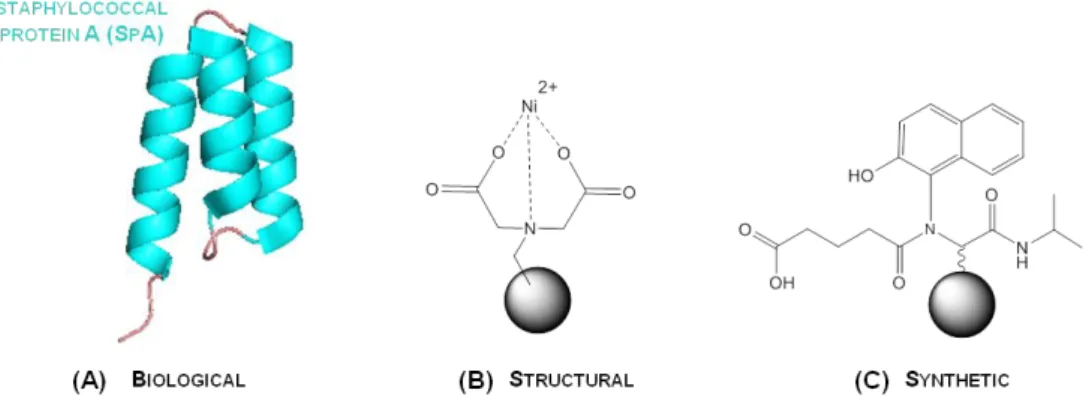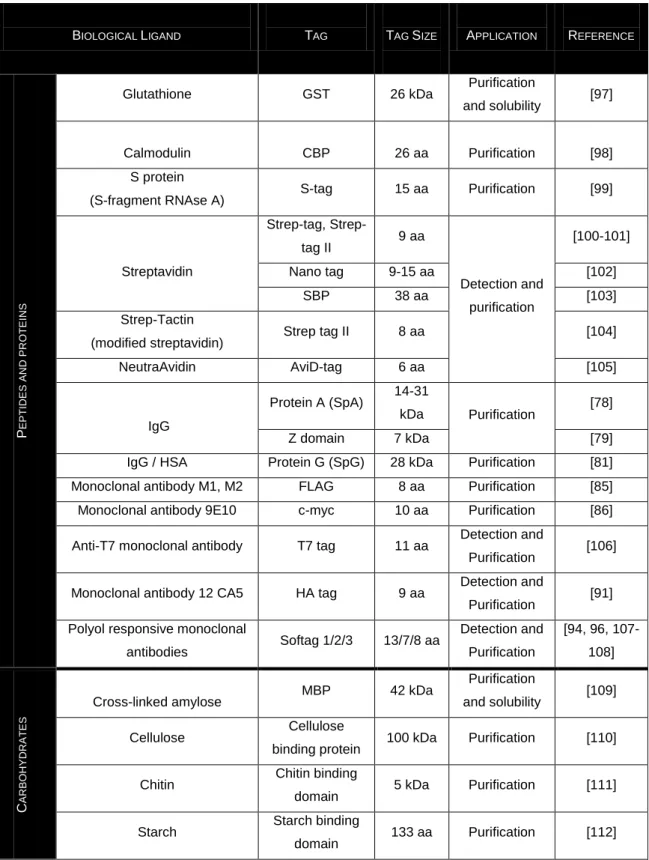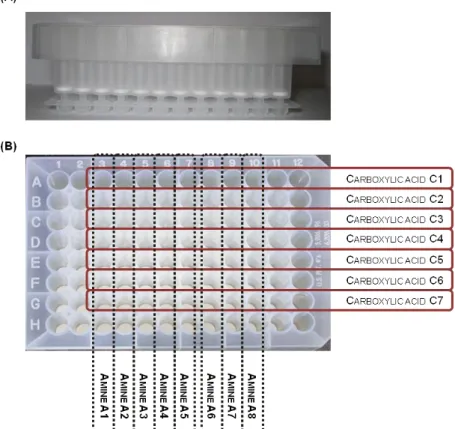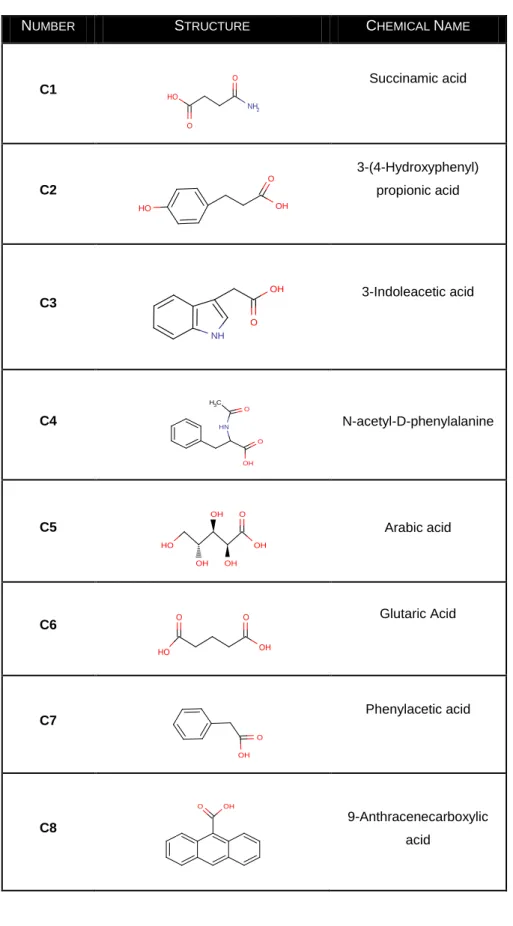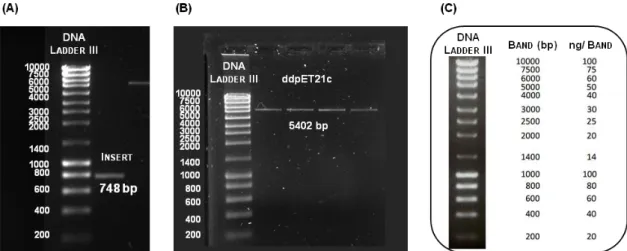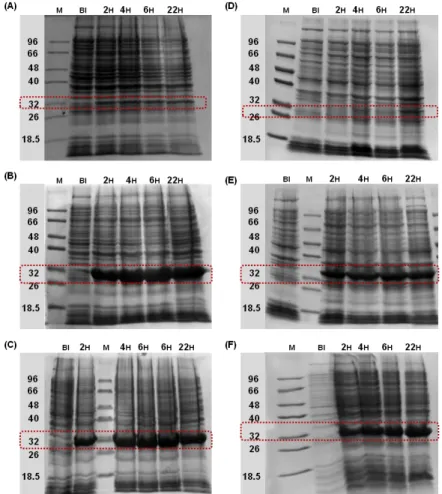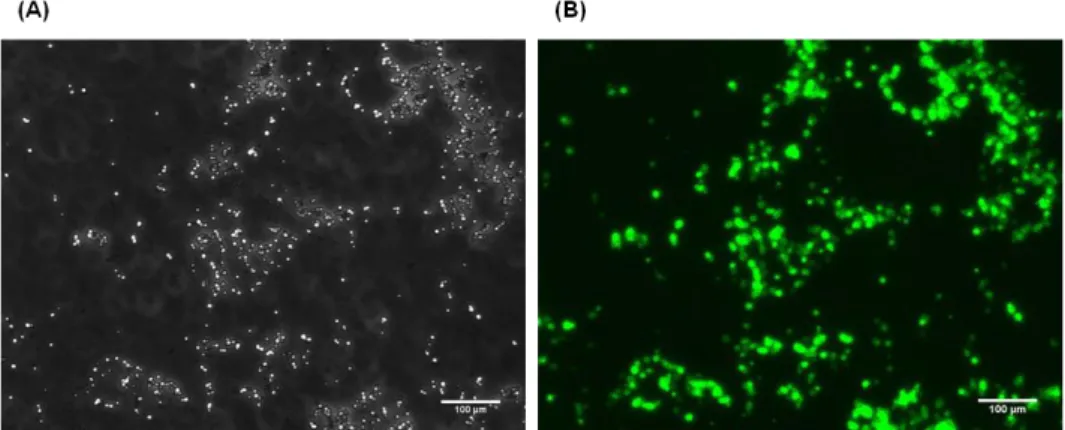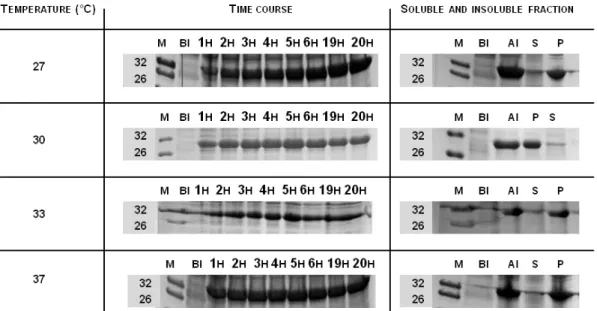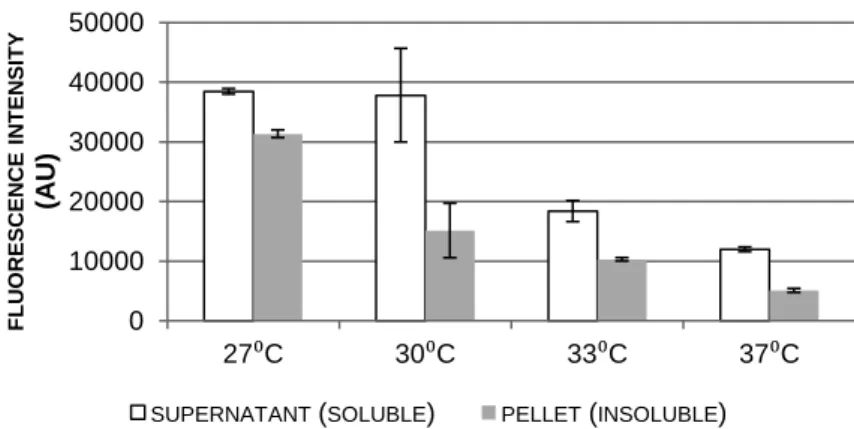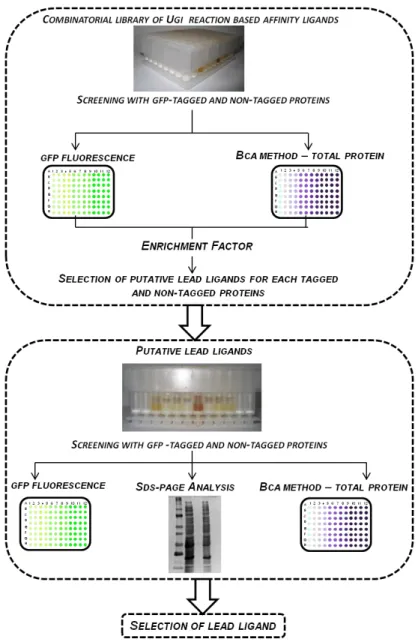Mestre em Biotecnologia
Novel affinity pairs "tag-receptor" for
the purification of fusion proteins
Dissertação para obtenção do Grau de Doutor em
Biotecnologia, ramo Biotecnologia
Orientador: Prof. Doutora Ana Cecília Afonso Roque
Co-orientador: Prof. Doutor Christopher Robin Lowe
Março 2013
iii
“Copyright”
Ana Sofia Fidalgo Pombo Mendes Pina Faculdade de Ciências e Tecnologia Universidade Nova de Lisboa
A Faculdade de Ciências e Tecnologia e a Universidade Nova de Lisboa têm o direito, perpétuo e sem limites geográficos, de arquivar e publicar esta dissertação através de exemplares impressos reproduzidos em papel ou de forma digital, ou por qualquer outro meio conhecido ou que venha a ser inventado, e de a divulgar através de repositórios científicos e de admitir a sua cópia e distribuição com objectivos educacionais ou de investigação, não comerciais, desde que seja dado crédito ao autor e editor.
v
The PhD has always been a challenge during these four years allowing me the opportunity to work in different areas and therefore to have a broader view of science. However, the performance of this PhD was not possible without the support and encouragement of several people.First of all, I would like to sincerely acknowledge my supervisors Prof. Cecília Roque and Prof. Chris Lowe, that gave me the opportunity to work on this project and together we were able to conduct a successful work. Dear Prof. Cecilia, all these achievements were not possible without your support, confidence, exigency, constructive criticism and friendship, and mostly helped me to be a more mature person at scientific level. Dear Prof. Chris Lowe, I am very thankful to your pertinent suggestions that gave me the motivation to improve the work developed during my PhD, and also for your support and trust. For all these reasons, I do not have enough words to express my gratitude.
I also would like to thank to Biomolecular Engineering Group: Íris Batalha, Telma Barroso,
Margarida Dias, Susana Palma, Vijaykumar Dhadge, Dr Abid Hussain, Dr Ricardo Branco and most recently Henrique Carvalho, Cláudia Fernandes and Bianca Gonçalves! All members contributed to the goals achievement during my PhD in a friendly and fun environment. Íris Batalha, Telma Barroso and Dr. Abid Hussain were with me since the very beginning, many thanks for all your support and friendship! Dr. Abid Hussain, I am very grateful for all the help regarding the affinity chromatography technique and your patience to introduce me all the
methods for the synthesis of affinity ligands. Íris Batalha, my great friend with an “eagle eye”,
thank you for your critical personality that is unbelievable, and obviously for your companionship! Telma Barroso, this endurance test, that is the PhD, became easier with you! More than a colleague, you are a really good friend, always there for me! A special thanks to dear Margarida Dias who helped to improve this work, for the helpful discussions, friendship and unique personality. Thanks also to Sara Santana for the unforgettable brainstorming. Susana Palma and Vijay, you were a pleasant surprise! To all members from the past and present, Many Thanks!
To all my lab colleagues at the Institute of Biotechnology in Cambridge, my sincere acknowledgments specially to Dr Graziella El Khoury, Dr Isik Ustok, Dr Rhian Grainger Jacky Kourieh, Nan Li, Chen Chen, Srishti Gupta and Anil Bagha. My dear “Doctors Graziella”, you were tireless with your help on studies with the automated liquid chromatography ÄKTA avant 25 equipment. Thank you for your motivation and trust! Dear Isik, thank you for your interest and availability in helping me with production of GFP fusion proteins for different applications of my PhD.
vi
I would like to express my gratitude to Prof Alice Pereira and Dr Márcia Guilherme to introduce me to molecular biology and protein expression methods as well as their availability to reply and clarify all my doubts. A special thanks to Molecular Biophysics lab in particular to Dr Filipe Folgosa, Sara Matias and Daniela Penas for their helpful discussions. I also like to thank Dr Américo Duarte and Ana Teresa Lopes for their availability and assistance.
I also like to thank to Dr Pedro Vidinha and Diana Garcia for providing E.coli K12 and helping me on the antimicrobial assays. Dr Paulo Lemos, a sincere acknowledgement for helping on the Fluorescence Microscopy and Image J.
A special thanks to “Gang do Tupperware” for provide me relaxed and amusing moments every day during lunch time for this last four years. All these moments helped me on my motivation to carry out my PhD thesis. Leonor Morgado and Tânia Carvalho, I am really thankful for your support and friendship during my PhD, especially in the last moments of panic! Apart from REQUIMTE colleagues, you are more than good friends for me. A special thanks to Inês Grilo for the helpfull discussions on the molecular biology experiments and obviously for the friendship,
I would like to acknowledge D. Maria José Carapinha, Isabel Rodrigues and Cara Bootman for their assistance on solving bureaucratic work and to D. Maria da Palma Afonso for providing clean tools for our research.
To all my friends and “Gang do Regabofe”, many thanks for always being there for me (even if we are far away on the map, we are close by heart), for your support and friendship! My life is much richer with you around me!
To all my family, especially to my parents, I am very grateful to have you supporting me. My dear grandparents, I am very thankful for your interest in understanding the science more specifically what I have been doing this last four years. Mum and Dad, you are the true inspiration in my life! I am thankful to you for the person that I am today with all the values and principles that you taught me during my entire life and I will never have enough words to thank you and I love you very much!
My dear Zé, you know what you mean for me! Thank you for love, patience, encouraging words and for always believes in me! My life is much better with you by my side!
Lastly, I would like to thank to Fundação para a Ciência e Tecnologia (FCT, Portugal) for the financial support through the PhD fellowship SFRH/BD/48804/2008 and the project
PTDC/BIO/65383/2006 assigned to Prof. Cecíla Roque and also to Associate Laboratory
vii
This work aimed at the development of novel affinity pairs “tag-receptor” as generic platforms for the purification of recombinant proteins. Five different hexapeptides with the sequences RWRWRW, WFWFWF, NWNWNW, RKRKRK and NNNNNN were selected as affinity tags to be fused to Green Fluorescent Protein (GFP). The respective DNA fragments were designed, cloned in pET21c expression vector and expressed in Escherichia coli host as soluble proteins except for the WFWFWF tagged GFP. A solid phase combinatorial library based on the Ugi reaction was synthesized with 64 affinity ligands displaying complementarity functionalities towards the designed tags. The library was screened by microscale affinity chromatography in a 96-well format for binding to GFP and GFP-tagged proteins, leading to the selection of four putative lead ligands A4C8, A3C4, A7C1, and A4C7 for WFWFWF, NWNWNW and RKRKRKfusion proteins and non-tagged GFP, respectively. The affinity pair WFWFWF tagged GFP –
A4C8 was explored for matrix assisted refolding. The affinity pair NWNWNW tagged GFP-A3C4 revealed extremely low protein recovery. The affinity pair RKRKRK tagged GFP-A7C1 emerged as a promising pair, as the ligand yielded 30% of protein recovery with a purity of 50% by using
arginine as competitor agent. Additionally, the pair displays a Ka of 2.45x105 M-1 and a Qmax of
0.5 mg GFP-tagged per gram of moist gel. A novel strategy for the purification of non-tagged GFP or GFP fusion proteins was also accomplished with ligand A4C7 that allowed a selective recovery of GFP with 92% yield and 94% purity. Moreover, the pair displayed a suitable Ka of
2.3x105 M-1 and a Qmax of 1 mg of GFP.per gram of moist gel.
ix
O objetivo desta tese consistiu no desenvolvimento de pares de afinidade “etiqueta-recetor” para a purificação por afinidade de proteínas recombinantes. Cinco hexapéptidos com sequências RWRWRW, WFWFWF, NWNWNW, RKRKRK and NNNNNN foram selecionadoscomo etiquetas de afinidade para serem utilizadas como proteínas de fusão com a “Green
Fluorescent Protein” (GFP). Os respetivos fragmentos de ADN foram desenhados, clonados no vetor de expressão pET21c e produzidos em Escherichia coli sob a forma solúvel, à exceção de WFWFWF-GFP. A biblioteca combinatorial foi sintetizada em fase sólida, tendo por base a reação de Ugi, apresentando 64 ligandos de afinidade com funcionalidades complementares para as etiquetas desenhadas. A avaliação da interação da biblioteca para a GFP e proteínas de fusão com a GFP foi efetuada através de cromatografia de afinidade em micro-escala, resultando na seleção de quatro ligandos de afinidade A4C8, A3C4, A7C1 e A4C7 para as proteínas de fusão marcadas com WFWFWF, NWNWNW, RKRKRK e GFP não marcada, respetivamente. A proteína WFWFWF-GFP foi explorada para estudos de enrolamento utilizando a matriz de afinidade com o ligando A4C8. O par de afinidade NWNWNW- GFP e A3C4 revelou baixos rendimentos na recuperação da proteína de fusão. O par de afinidade RKRKRK -GFP e A7C1 emergiu como um par promissor, tendo o ligando permitido uma recuperação de 30% da proteína de fusão com uma pureza de 50%, utilizando arginina como
agente competidor. Adicionalmente, o par de afinidade apresentou um Ka de 2.45x105 M-1 e um
Qmax de 0.5 mg/g de resina. Uma nova estratégia para a purificação de GFP foi também
desenvolvida, sendo que adsorventes com o ligando A4C7 permitiram uma recuperação
seletiva de GFP com 92% de rendimento e 94% de pureza, apresentando um Ka de 2.3x105 M
-e Qmax d-e 1 mg GFP/g r-esina
PALAVRAS CHAVE- Proteína de fusão, Etiqueta de afinidade, Ligando biomimético, Cromatografia de afinidade, GFP
xi
PAGE ACKNOWLEDGEMENTS ... V RESUMO ... IX TABLE OF CONTENTS ... XI INDEX OF FIGURES ... XV INDEX OF TABLES ... XXI ABBREVIATIONS ... XXIII BACKGROUND ... XXVCHAPTER 1 : AFFINITY PAIRS TAG-LIGAND FOR THE PURIFICATION OF RECOMBINANT PROTEINS ... 1
1.1 AFFINITY LIGANDS FOR RECOMBINANT PROTEIN PURIFICATION ... 2
1.2. PURIFICATION OF FUSION PROTEINS BY TAG-AFFINITY LIGAND STRATEGIES ... 5
1.2.1. Biological ligands as binding partners of affinity tags ... 8
1.2.2. Structural ligands as binding partners of affinity tags ... 14
1.2.3. Affinity tags with versatile properties ... 20
1.3 TAG REMOVAL ... 22
1.4 CONCLUDING REMARKS AND FUTURE TRENDS ... 22
CHAPTER 2: MATERIALS AND METHODS ... 25
2.1 MATERIALS ... 26 2.1.1 Chemicals ... 26 2.1.2 Biochemicals ... 27 2.1.3 Chromatographic materials ... 27 2.2 INSTRUMENTATION ... 27 2.3 GENERAL METHODS ... 29
2.3.1 Solid phase combinatorial synthesis of the library of Ugi-based affinity ligands ... 29
2.3.1.1 Epoxyactivation of agarose beads ... 29
2.3.1.2 Aldehyde functionalization of agarose beads ... 30
2.3.1.3 Synthesis of the solid phase combinatorial library ... 30
2.3.2 Production of crude extracts containing GFP-tagged and non-tagged GFP ... 35
2.3.2.1 Molecular Cloning of RWRWRW-GFP encoded gene in a pET-21c expression vector ... 35
2.3.2.2RWRWRW tagged GFP small scale expression studies ... 42
2.3.2.3Large scale expression of RWRWRW tagged GFP ... 44
2.3.2.4 Large scale expression of the remaining fusion proteins and GFP ... 46
2.3.2.5Antimicrobial assays with hexapeptide RWRWRW (RW)3 ... 46
2.3.2.6. Production of RWRWRW tagged GFP in E.coli BL21(DE3) cells ... 47
2.3.2.7. Production Inclusion bodies (IBs) with the WFWFWF-GFP system ... 47
xii
2.3.3 Screening of library based on the Ugi reaction with crude extracts containing
GFP-tagged and non-GFP-tagged ... 49
2.3.4 Synthesis and re-screening of the promising lead ligands and the respective crude extracts containing GFP-tagged and non-tagged ... 50
2.3.4.1 Synthesis of the promising lead ligands ... 50
2.3.4.2 Screening of the promising lead ligands and the respective crude extracts containing GFP-tagged and non-tagged ... 51
2.3.5 Optimization and characterization of the lead affinity pairs “tag-receptor” ... 52
2.3.5.1 Scale-up synthesis of lead affinity ligands ... 52
2.3.5.2 Screening of the lead ligands with the respective target in on-column format .... 52
2.3.5.3 Lead ligands selectivity ... 53
2.3.5.4 Determination of the binding constants ... 53
2.3.5.5 Optimization of the elution profile for the lead affinity pairs ... 53
2.3.5.6 Study of the lead affinity pairs in the automated system ÄKTA avant 25 ... 56
CHAPTER 3: PRODUCTION OF GFP-TAGGED PROTEINS ... 59
3.1 INTRODUCTION ... 60
3.2 FRAGMENT DNA DESIGN ... 61
3.3 MOLECULAR CLONING OF RWRWRW-GFP ENCODING GENE IN A PET-21C VECTOR ... 63
3.4. RWRWRW TAGGED GFP SMALL SCALE EXPRESSION STUDIES ... 65
3.5. LARGE SCALE EXPRESSION OF GFP TAGGED PROTEINS ... 69
3.5.1Production of GFP tagged proteins ... 69
3.5.2.Antimicrobial properties of the RWRWRW-GFP system ... 76
3.5.2.1 Antimicrobial assays with (RW)3 ... 77
3.5.2.2. Production of RWRWRW tagged GFP in E.coli BL21(DE3) cells ... 78
3.5.3Production of inclusion bodies with the WFWFWF tagged GFP system ... 79
3.5.3.1Solubilization and Refolding Strategies ... 79
3.5.3.2How to avoid inclusion bodies? ... 80
3.5.3.2.1 Inductor levels Influence ... 80
3.5.3.2.2 Temperature Influence ... 83
3.6. CONCLUDING REMARKS ... 86
CHAPTER 4: COMBINATORIAL LIBRARY SCREENING WITH CRUDE EXTRACTS CONTAINING GFP-TAGGED AND NON-TAGGED PROTEINS ... 89
4.1 INTRODUCTION ... 90
4.2. SYNTHESIS OF A COMBINATORIAL LIBRARY OF AFFINITY LIGANDS ... 92
4.3. SCREENING OF THE UGI BASED COMBINATORIAL LIBRARY ... 94
4.3.1. Screening with RWRWRW tagged GFP crude extract ... 99
4.3.2. Screening with WFWFWF tagged GFP crude extract ... 103
4.3.2.1 Screening under Non denaturing conditions ... 103
xiii
4.3.5. Screening with NNNNNN tagged GFP crude extract ... 117
4.3.6. Screening with non-tagged GFP extract ... 118
4.4 SELECTION AND RE-SCREENING OF THE PUTATIVE LEAD LIGANDS ... 122
4.4.1. Re-Screening with RWRWRW tagged GFP crude extract ... 123
4.4.2. Re-Screening with WFWFWF tagged GFP crude extract ... 125
4.4.2.1 Non-Denaturing Conditions ... 125
4.4.2.2 Denaturing Conditions ... 127
4.4.3 Re-Screening with NWNWNW tagged GFP crude extract ... 129
4.4.5 Re-Screening with non-tagged GFP crude extract ... 134
4.5. THE LEAD AFFINITY PAIRS “TAG-RECEPTOR” ... 137
4.6 CONCLUDING REMARKS ... 138
CHAPTER 5: OPTIMIZATION AND CHARACTERIZATION OF THE LEAD AFFINITY PAIRS “TAG-RECEPTOR” ... 141
5.1 INTRODUCTION ... 142
5.2. COMPARISON OF THE AFFINITY SYSTEMS PERFORMANCE ON 96-WELL FORMAT AND ON-COLUMN ... 143
5.3 LEAD LIGANDS SELECTIVITY ... 147
5.4 DETERMINATION OF BINDING CONSTANTS ... 149
5.5 OPTIMIZATION OF THE ELUTION PROFILE FOR THE LEAD AFFINITY PAIRS ... 153
5.5.1 Affinity pair NWNWNW tagged GFP-A3C4 ... 157
5.5.2 Affinity pair RKRKRK tagged GFP - A7C1 ... 159
5.5.3 Affinity pair GFP-A4C7 ... 163
5.6 SCALE UP OF THE AFFINITY PAIRS ... 168
5.6.1 Affinity pair WFWFWF tagged GFP - A4C8 under denaturing conditions ... 168
5.6.2 Affinity pair NWNWNW tagged GFP-A3C4 ... 170
6.6.3 Affinity pair RKRKRK tagged GFP-A7C1 ... 174
5.6.4 Affinity pair non-tagged GFP- ligand A4C7 ... 178
5.6.5 Purification of GFP fusion proteins with A4C7 ligand ... 182
5.8 CONCLUDING REMARKS ... 185
CHAPTER 6: CONCLUDING REMARKS ... 187
xv
PAGE
Figure 1.1 Overview of the classes of affinity ligands employed on affinity chromatography...3 Figure 1.2 Overview of a recombinant fusion protein purification process through the use of affinity tags fused to the target protein………...7 Figure 2.1 Aldehyde functionalization of agarose beads...29 Figure 2.2 Reactional scheme of the multicomponent Ugi reaction synthesized in the solid phase...31 Figure 2.3 Visualization of the reactional 96-well filtration block used for the synthesis of the combinatorial libraries based on the Ugi reaction...32 Figure 3.1 Production of affinity tags fused to GFP...61 Figure 3.2 Scheme of the (A) fragment DNA and (B) respective nucleotide sequence that encodes for RWRWRW tagged GFP...62 Figure 3.3 Hydrolysis with restriction enzymes Nhe I and EcoR I of (A) pAP001 plasmid that carries the gene encoding for RWRWW-GFPfusion protein (insert) and (B) pET-21c expression vector...63 Figure 3.4 DNA quantification of the insert (A) and the double digested expression vector (B) by agarose gel electrophoresis (0.8 % (w/v) agarose) analysis using the (C) NZYDNA Ladder III from Nzytech...64 Figure 3.5 Evaluation of the hydrolysis of pAP001 of twelve selected colonies obtained from the subcloning procedure with restriction enzymes Nhe I and EcoR I by agarose gel electrophoresis (0.8 % (w/v) agarose) ...65 Figure 3.6 Quantification of RWRWRW tagged GFP by GFP fluorescence spectroscopy, produced by induction of gene expression at an optical density 0.6-0.8 in E. coli BL21(DE3) cultures...67 Figure 3.7 SDS-PAGE evaluation of the amount RWRWRW tagged GFP produced over time, when using different concentrations of IPTG (A) 0.1 mM, (B) 0.5 mM, (C) 1 mM, (D) 1.5 mM and (E) 2 mM at optical density 0.6-0.8………...67 Figure 3.8 GFP fluorescence intensity monitoring of the expression of RWRWRW tagged GFP when inducing the gene expression at optical density of 2...68 Figure 3.9 SDS-PAGE evaluation of the amount RWRWRW tagged GFP produced over the time, when using different concentrations of IPTG (A) 0.1 mM, (B) 0.5 mM, (C) 1 mM, (D) 1.5 mM and (E) 2 mM at optical density 2...69 Figure 3.10 Correlation between the GFP fluorescence intensity and optical density measurements with induction time during the large-scale expression……….71 Figure 3.11 Normalization of the GFP fluorescence intensity with the respective optical density measurements for all the affinity tags fused to GFP...72 Figure 3.12 SDS-PAGE time course of large scale production of GFP tagged proteins in E. coli BL21(DE3)...72 Figure 3.13 Cellular fractionation analyzed by SDS-PAGE...74
xvi
Figure 3.14 Inclusion bodies obtained for the WFWFWF-GFP production system…...76 Figure 3.15 Antimicrobial assays between different RWRWRW concentrations and E. coli
K12...77
Figure 3.16 Monitoring RWRWRW tagged GFP production on E. coli BL21(DE3) cells through GFP fluorescence intensity and optical density measurements over induction time and growth curve for E. coli BL21(DE3) cells...78 Figure 3.17 Impact of IPTG concentration on the expression of WFWFWF tagged GFP at (A) 30 °C and (B) 37 °C ...81 Figure 3.18 SDS-PAGE analysis of the soluble and insoluble WFWFWF tagged GFP produced over the induction time for different concentrations of IPTG at (A) 30ºC and (B) 37ºC...82 Figure 3.19 GFP fluorescence intensity of soluble and insoluble forms of WFWFWFW tagged GFP obt*ained after protein expression induced at 0.6-0.8 with different IPTG concentrations at (A) 30 ºC and (B) 37 ºC...83 Figure 3.20 Impact of expression temperatures on the overall productivity of WFWFWF tagged GFP...84 Figure 3.21 SDS-PAGE analysis of the soluble and insoluble WFWFWF tagged GFP produced over the induction time for different temperatures ...84 Figure 3.22 GFP fluorescence intensity of soluble and insoluble forms of WFWFWFW tagged GFP obtained after protein expression induced at 0.6-0.8 with 1 mM of IPTG at different expression temperatures ...85 Figure 3.23 Fluorescence microscopy analysis of the insoluble form of WFWFWF tagged GFP produced at different temperatures with 1 mM IPTG...85 Figure 4.1 Strategy for the selection of lead ligands...92 Figure 4.2 Diversity of the compounds used in the synthesis of the Ugi based combinatorial libraries...94 Figure 4.3 Peptide structures used as affinity tags...98 Figure 4.4 Screening of combinatorial library for RWRWRW tagged GFP...100 Figure 4.5 Putative lead ligands structures with an enrichment factor ~ 5 for the RWRWRW tagged GFP...100 Figure 4.6- Putative lead ligands structures with an enrichment factor ~3- 4 for the RWRWRW tagged GFP...101 Figure 4.7 Putative lead ligands structures with an enrichment factor ~2- 3 for the RWRWRW tagged GFP...102 Figure 4.8 Correlation between (A) the isolectric point and (B) Log P values of the selected putative lead ligands and the respective value of the enrichment factor obtained from the screening with the RWRWRW tagged GFP...103 Figure 4.9 Screening of combinatorial library for WFWFWF tagged GFP under non denaturing conditions...104
xvii
conditions...105
Figure 4.11 Structures of the putative lead ligands with enrichment factors ~2-4 that contain the same amine A2 for the WFWFWF tagged GFP under non-denaturing conditions ...105
Figure 4.12 Structures of the putative lead ligands with enrichment factors ~2-4 that contain the same amine A3 for the WFWFWF tagged GFP under non-denaturing conditions...106
Figure 4.13 Correlation between (A) the isolectric point and (B) Log P values of the selected putative lead ligands and the respective value of the enrichment factor obtained from the screening with the WFWFWF tagged GFP...106
Figure 4.14 Screening of combinatorial library for WFWFWF tagged GFP under denaturing conditions...109
Figure 4.15 Structures of the selected putative lead ligands for the WFWFWF tagged GFP under denaturing conditions...110
Figure 4.16 Screening of combinatorial library for NWNWNW tagged GFP...111
Figure 4.17 Putative lead ligands for NWNWNW tagged GFP, where ligand A7C8 presents an enrichment factor ~6 and ligands A6C8 and A3C5 ~5...112
Figure 4.18 Promising lead ligands for NWNWNW tagged GFP, where ligand A2C5 presents an enrichment factor ~4 and ligands A5C1 and A5C6 ~3...112
Figure 4.19 Lead ligands for NWNWNW tagged GFP with a common A2 amine and enrichment factor ~2...113
Figure 4.20 Lead ligands for NWNWNW tagged GFP with a common A3 amine and enrichment factor ~2...113
Figure 4.21 Correlation between (A) the isolectric point and (B) Log P values of the selected putative lead ligands and the respective value of the enrichment factor obtained from the screening with the NWNWNW tagged GFP...114
Figure 4.22 Screening of combinatorial library for RKRKRK tagged GFP ...115
Figure 4.23 Lead ligands A7C7 and A7C8 for RKRKRK tagged GFP...115
Figure 4.24. Lead ligands with A7 amine, with enrichment factor ~2 ...116
Figure 4.25 Ligands A2C4 and A5C4, selected as putative lead ligands for the RKRKRK tagged GFP...116
Figure 4.26 Correlation between (A) the isolectric point and (B) Log P values of the selected putative lead ligands and the respective value of the enrichment factor obtained from the screening with the RKRKRK tagged GFP...117
Figure 4.27 Screening of combinatorial library for NNNNNN tagged GFP...118
Figure 4.28 Screening of combinatorial library for GFP...119
xviii
Figure 4.30 Ligands selected also as putative lead ligands with enrichment factor ~1.4 -2 for GFP...120 Figure 4.31 Lead ligands for GFP with an enrichment factor ~1...121 Figure 4.32 Correlation between (A) the isolectric point and (B) Log P values of the selected putative lead ligands and the respective value of the enrichment factor obtained from the screening with the GFP...122 Figure 4.33 Estimation of GFP proteins retention onto the affinity adsorbents by SDS-PAGE analysis...123 Figure 4.34 (A) Binding of GFP and total protein for the putative lead ligands and RWRWRW
tagged GFP and (B) comparison of enrichment factor values obtained from the two screening
assays...124 Figure 4.35 SDS-PAGE evaluation of the screening of putative ligands and RWRWRW-GFP ...125 Figure 4.36 (A) Binding of GFP and total protein for the putative lead ligands and WFWFWF tagged GFP under non-denaturing conditions and (B) comparison of enrichment factor values obtained from the two screening assays...126 Figure 4.37 SDS-PAGE evaluation of the screening of putative ligands for WFWFWF tagged GFP...127 Figure 4.38 Binding of GFP for the putative lead ligands and WFWFWF tagged GFP under denaturing conditions...128 Figure 4.39 SDS-PAGE evaluation of the screening of putative ligands for WFWFWF tagged GFP under denaturing conditions...128 Figure 4.40 (A) Binding of GFP and total protein for the putative lead ligands and NWNWN
tagged GFP and (B) comparison of enrichment factor values obtained from the screening
assays...129 Figure 4.41 SDS-PAGE evaluation of the screening of putative ligands and NWNWNW tagged GFP...130 Figure 4.42 (A) Binding of GFP and total protein for the putative lead ligands and RKRKRK
tagged GFP and (B) comparison of enrichment factor values obtained from the screening
assays...132 Figure 4.43 SDS-PAGE evaluation of the screening of putative ligands and RKRKRK tagged GFP...133 Figure 4.44 (A) Binding of GFP and total protein for the putative lead ligands and GFPand (B) comparison of enrichment factor values obtained from the screening assays...135 Figure 4.45 SDS-PAGE evaluation of the screening of putative ligands and GFP...136 Figure 4.46 Lead ligands selected for GFP tagged proteins and non-tagged GFP...137 Figure 4.47 Binding evaluation (µg bound/ g resin) of each one of the GFP tagged proteins and non-tagged GFP and the respective affinity ligand...138 Figure 5.1 Different stages required for the optimization of the lead affinity systems...143
xix
...145 Figure 5.3 Comparison of the percentage of binding of (A) GFP protein and (B) total protein for the 96 well format and on-column for blank agarose...146 Figure 5.4 Selectivity of the ligands A3C4 and A7C1...147 Figure 5.5 SDS-PAGE analysis of the binding A3C4 to (A) RKRKRK tagged GFP and (B) GFP...148 Figure 5.6.SDS-PAGE analysis of the binding A7C1 to (A) NWNWNW tagged GFP and (B) GFP...148 Figure 5.7 Adsorption and desorption scheme between an immobilized affinity ligand and a target protein...149 Figure 5.8 Binding isotherms and resulting static binding capacities for the affinity pairs (A) NWNWNW tagged GFP and A3C4, (B) RKRKRK tagged GFP and A7C1 and (C) GFP and A4C7...152 Figure 5.9 Strategy for the optimization of the elution conditions...156 Figure 5.10 Microspecies distribution (%) for the ligand A3C4 over the pH values between 3 and 11...158 Figure 5.11 Influence of pH on the charge of the NWNWNW peptide without free C-terminal...158 Figure 5.12 Microspecies distribution (%) for ligand A7C1 over pH values between 3 and 11...160 Figure 5.13 Influence of pH on the charge of RKRKRK peptide without free C- terminal...160 Figure 5.14 Influence of the different elution buffers on the recovery of RKRKRK tagged GFP...161 Figure 5.15 Second approach for the optimization of the elution conditions for the recovery of RKRKRK tagged GFP...163 Figure 5.16 Influence of the different elution buffers on the recovery of GFP...165 Figure 5.17 Microspecies distribution (%) for the ligand A4C7 over pH values between 3 and 11...165 Figure 5.18 Crystal structure of GFP protein (1QYO)...166 Figure 5.19 Second approach for the optimization of the elution conditions for the recovery of GFP...167 Figure 5.20 Strategy used for the refolding of the WFWFWF tagged GFP on A4C8functionalized matrix performed on the AKTATM avant 25 with the expected chromatogram
...169 Figure 5.21 SDS-PAGE analysis of the samples from the purification of WFWFWF tagged GFP
xx
Figure 5.22 Percentages of NWNWNW tagged GFP bound, eluted and regenerated from affinity adsorbent containing A3C4...171 Figure 5.23 Chromatograms obtained for the purification of NWNWNW tagged GFP with affinity ligand A3C4...172 Figure 5.24 SDS-PAGE analysis of the samples from the purification of NWNWNW tagged GFP and the ligand A3C4...172 Figure 5.25 Percentages of RKRKRK tagged GFP bound, eluted and regenerated from affinity adsorbent containing A7C1...175 Figure 5.26 Chromatograms obtained for the purification of RKRKRK tagged GFP with affinity ligand A7C1...176 Figure 5.27 SDS-PAGE analysis of the samples from the purification of RKRKRK tagged GFP
and the ligand A7C1...176
Figure 5.28 Percentages of GFP bound, eluted and regenerated from affinity adsorbent containing A4C7...178 Figure 5.29 Chromatograms obtained for the purification of GFP with affinity ligand A4C7...179 Figure 5.30 SDS-PAGE analysis of the samples from the purification of GFP and the ligand A4C7...180 Figure 5.31 Percentages of GFP fusion protein bound, eluted and regenerated from affinity adsorbent containing A4C7...182 Figure 5.32 Chromatograms obtained for the purification of GFP fusion protein with affinity ligand A4C7...183 Figure 5.33 SDS-PAGE analysis of the samples from the purification of GFP fusion protein and the ligand A4C7...183 Figure 5.34 SDS-PAGE analysis obtained from the chromatographic assays from the purification of GFP fusion protein and the ligand A4C7 when using 0.1M Glycine-NaOH pH 9 50% ethylene glycol...184
xxi
PAGE Table 1.1 Comparison the affinity ligands employed on purification of proteins through affinity chromatography...5 Table 1.2 Comparison of the general properties of proteins and peptides used as affinity tags ...8 Table 1.3 Overview of biological ligands involved as binding partners of affinity tags...10 Table 1.4 Examples of a peptide and protein affinity tags and their respective biological ligands employed on the purification of fusion proteins based on affinity chromatography...11 Table 1.5 Overview of the structural ligands involved as binding partners of affinity tag...16 Table 1.6 Examples of commercially available affinity tags and respective purification supports based on biological ligands...18 Table 1.7 Examples of commercially available affinity tags and respective purification supports based on structural ligands...19 Table 2.1 List of the amines compounds used on the Ugi reaction for the solid phase combinatorial library...33 Table 2.2 List of the carboxylic acid and isocyanide compounds used on the Ugi reaction for the solid phase combinatorial library...34 Table 2.3 Promising lead ligands selected for each respective target from the first screening between the combinatorial library based on the Ugi reaction and the crude extracts containing GFP-tagged and non-tagged...51 Table 2.4 Elution conditions employed on the first approach of the optimization...54 Table 2.5 Elution conditions employed on the second approach of the optimization...55 Table 2.6 Best elution conditions employed on the screening between the affinity pairs on the ÄKTA avant 25 automated system...57 Table 3.1 Percentage of tagged and non-tagged GFP produced over the total amount of total protein produced by E.coli cells...75 Table 3.2 Expression profiles summary of each affinity tag fused to GFP………...87 Table 4.1 Maximum values of the enrichment factor expected with GFP-tagged and non-tagged proteins...97 Figure 4.2 Properties of the peptides used as affinity tags...99 Table 4.3 Putative lead ligands selected for each of the GFP-tagged and non-tagged proteins...122 Table 4.4 Elution of RKRKRK tagged GFP at pH 11...133 Table 5.1 Kinetic parameters obtained for each of the affinity pairs after fitting with Langmuir model...153 Table 5.2 Comparison of the results obtained for the affinity pair NWNWNW tagged GFP/A3C4 ...173 Table 5.3 Comparison of the results obtained for the affinity pair RKRKRK tagged GFP/A7C1...177
xxii
Table 5.4 Comparison of the results obtained for the affinity pair GFP/A4C7...181 Table 6.1 Comparison of the RKRKRK affinity tag with similar tags commercial available...190 Table 6.2 Purification methods used on the purification of Green Fluorescent Protein (GFP).191
xxiii
AMP – Antimicrobial peptideATPS - Aqueous two-phase solvent BSA – Bovine Serum Albumin BCA - Bichinchoninic Acid
CBP – Calmodulin binding protein CIP- Cleaning-in-place
CMA - Carboxymethylaspartate
DDDDK – Peptide with four Aspartic acid residues and one Lysine residue DNA - Deoxyribonucleic acid
DTT- DL-Dithiothreitol E.coli – Escherichia coli
EDTA - Ethylenediaminetetraacetic acid EGTA – Ethylene glycol tetraacetic acid ELPs Elastin-like polypeptides
FITC - Fluorescein isothiocyanate GFP - Green Fluorescent Protein GST- Glutathion-S-trabsferase
HIC – Hydrophobic interaction chromatography His-tag –Histidine hexapeptide
HSA- Human serum albumin HTS - High Throughput Screening IDA - Iminodiacetic acid
IEX – Ion-exchange chromatography IgG - Immunoglobulin G
IMAC - Immobilized metal affinity chromatography IPTG - β-D-1-thiogalactopyranoside
LB - Luria Broth
MCR – Multicomponent reaction MBP – Maltose binding protein
NNNNNN - Peptide with six asparagine residues NTA - Nitrilotriacetic acid
NWNWNW: Peptide with asparagine and tryptophan residues NusA- N-utilization substance A
OD600 – Optical density at 600 nm
PBS – Phosphate buffered saline buffer PDB: Protein data bank
PolyArg - Polyarginine-tag PVDF – polyvinylidene difluoride
xxiv
RWRWRW: Peptide with arginine and tryptophan residues RKRKRK: Peptide with arginine and lysine residues
R1: Substitution of the first chloride of triazine immobilized on to agarose R2: Substitution of the second chloride of triazine immobilized on to agarose SBP - Strepdavidin-binding peptide
SDS-PAGE - Sodium dodecyl sulfate polyacrylamide gel electrophoresis SIP- Sterilization-in-place
SpA - Staphylococcal protein A SpG - Staphylococcal protein G TAG- Triacylglycerol
TAP- Tandem affinity chromatography SPR – Surface Plasmon resonance TEMED - Tetramethylethylenediamine Tris -Tris(hydroxymethyl)aminomethane Trx - thioredoxin
WFWFWF: Peptide with tryptophan and phenylalanine residues TACN - 1,4,7-triazacyclononane
xxv
The market of therapeutic proteins represents one of the fastest-growing segments ofpharmaceutical industry and the most prominent best-selling classes include monoclonal
antibodies, hormones and growth factors [1-2]. With the advances on genetic engineering it became possible the production of the therapeutic proteins in different microorganisms where Escherichia coli represents the most widely used platform, covering 30% of the total production of recombinant proteins among mammalian, insect and yeast cells [2]. Along with these advances, regulatory demands on purity became stricter, and the cost-effectiveness of the end product has been a driving force for the development of more efficient downstream processes [3-5].
Currently, there is not a universal strategy for the purification of recombinant proteins, as the individual biochemical and biophysical properties of each target protein dictate the production and the purification process. Affinity chromatography is considered the most widely used chromatographic method on the downstream processing due to the high yields of recovered protein with purity over 90% [3, 6], but there is a lack of suitable affinity ligands for a wide range of proteins. Moreover, the diversity of proteins makes the development of general purification and capturing strategies difficult. Therefore, the incorporation of a genetically encoded purification affinity tag is an attractive choice for the purification of recombinant proteins, while contributing for a reduction on the number of chromatographic processes involved in a purification scheme [7-8].
The use of purification affinity tags requires a respective binding receptor immobilized onto a chromatographic matrix and their use is dependent on the molecular recognition mediated by the non-covalent interactions and the complementarity between the pair tag-receptor [9]. To date, the purification affinity tags commercially available and those referred in the literature, are not specifically designed to the receptor. The common receptors comprise biological and structural ligands that are able to recognize peptides or proteins used as purification affinity tags. One group of tags includes native or engineered proteins: enzymes (e.g. Gluthathione-S-transferase), protein binding domains (e.g. protein A and Z domain) and carbohydrate binding domains (e.g. maltose-binding protein) [7-8, 10-11]. The other group of purification tags encloses peptides: antigenic epitopes (e.g. FLAG), protein-binding peptides (e.g. calmodulin-binding peptide), streptadivin-calmodulin-binding peptides (e.g. Strep-tag), charged peptides (e.g.
poly-arginines), and metallo-binding peptides (e.g. poly-histidine) [7-8, 10-11]. Short peptide tags
present several advantages over larger tags (as proteins) as they are less likely to interfere with the expression, structure and function of the target recombinant protein and the cloning procedure is facilitated [8].
xxvi
The corresponding capturing affinity ligands comprise biological ligands (e.g. complementary monoclonal antibodies or haptens) and structural ligands (e.g. ion-exchange resins, metal-chelate) [7-8, 10-11]. In general, biological ligands tend to have high binding and specificity capacities, but also high associated costs, low stability and re-usability [12-14]. Available structural ligands are usually inexpensive to produce but display low selectivities and as a consequence the purity of the final protein can be compromised, in particular when using metal chelator ligands which are more prone to leaching [15-17].
A class of synthetic affinity ligands denominated as biomimetic ligands have been employed in the affinity purification of specific proteins such as immunoglobulins, [18-20], glycoproteins [21-22], prion proteins [23], human recombinant factor VII, [24] and elastases [25]. These can be de novo rationally designed for a specific target to better mimic the structure and binding of natural biological ligands [12-14, 26], and can present high selectivity combined with low production costs. Additionally, the biomimetic ligands are highly robust and can operate over a wide range of chemical conditions (e.g. pH, buffer composition, ionic strength) making cleaning in place and matrix re-utilization possible [12-14].
To date, there is no purification process based on the use of an affinity pair that combines a biomimetic ligand as a binding partner for a specific affinity tag.
Therefore, this project aims the development of a new “tag-receptor” to be used as generic platform for recombinant protein purification. The novelty of this work is the de
novo creation of a tailor-made affinity pair, where the tag will be a small peptide and the
1 CHAPTER 1
AFFINITY PAIRS TAG-LIGAND FOR THE PURIFICATION OF RECOMBINANT PROTEINS
SUMMARY
The purification of recombinant proteins based on affinity chromatography is one of the most efficient purification strategies that allows high recovery yields of and purity of the target protein. However, this strategy is dependent on the availability of affinity adsorbents. Adsorbents comprising synthetic affinity ligands which combine the selectivity of biological ligands with the cost-efectiveness of structural ligands are promising viable options. The diversity of proteins requires a generic platform for the purification of recombinant proteins. Therefore, genetically encoded affinity tags are an attractive and viable option, which only requires specific receptors for capturing the fusion protein through the affinity tag tail. There is a wide range of available affinity pairs “tag-receptor” combining biological or structural ligands with respective binding partners such as peptide or proteins tags
Although current affinity pairs are well established for purification purposes there is still a lack of compromise between high selectivity and affordable costs within the affinity pairs so far developed.
CHAPTER 1: AFFINITY PAIRS TAG-LIGAND FOR THE PURIFICATION OF RECOMBINANT PROTEINS
2
1.1 AFFINITY LIGANDS FOR RECOMBINANT PROTEIN PURIFICATION
Recombinant proteins produced through recombinant DNA technology present one of the major classes of biopharmaceuticals and include erythropoietin, insulin, interferons, colony-stimulating factors, blood factors and growth hormones, employed in the treatment of cancer, diabetes, auto-immune and growth disturbances, among many others [3, 27]. In 2009, therapeutic proteins were the leaders of the global biopharmaceutical industry with a market size of 50 billion Euros, and by 2016, the market is estimated to reach 120 billion Euros [27]. The manufacturing of biopharmaceuticals is constantly evolving to reach higher productivity, quality, and lower production costs [4-5, 28]. Upstream and downstream processing are intimately linked, where the former deals with the production and the latter with the separation steps to ensure a highly purified final product [5]. Downstream processing costs can be as high as 80% of the total production cost of a therapeutic recombinant protein [29-30]. This is mainly a consequence of the several purification steps needed, combined with the strict regulatory demands on purity, and the required optimization processes for each particular biologic target [3-5, 29]. Chromatography is a well established platform for downstream bioprocesses, being currently economically feasible and yielding recovery of bioproducts with purities as high as 97-99% [3, 5, 31-32]. Among the several chromatographic techniques available for bioseparation purposes, affinity chromatography is extremely popular [6] due to its high selectivity and reduction of process steps [5, 29, 33].
The concept of affinity chromatography emerged in the 1970’s and exploits the reversible and selective interaction between two entities: an affinity ligand immobilized on a solid support, and a target biomolecule to purify [14, 29-30, 34-35]. The solid supports most widely used in affinity purification are composed of cross-linked agarose, polymethacrylate, polycrylamide, cellulose, and silica, and include porous and non-porous particulates, membranes and monoliths [14, 34-37]. The properties required for an efficient and effective affinity separation matrix include chemical inertness, mechanical and chemical stability, proper pore and particle size [14, 34, 36-37]. The chemical inertness of the matrix is related with the minimization of nonspecific interactions between the matrix material and the target protein to be purified [34, 37]. As the support should interact in a minimal way with the mobile phase, the matrix support should be hydrophilic and non-charged to minimize the formation of ionic interactions [37]. Concerning the stability of the material, the matrix must be physically and chemically stable under a wide range of conditions including those employed during surface modification, protein adsorption, elution, regeneration, matrix sterilization in place (SIP) and cleaning in place (CIP). These conditions include extreme pH values, high and low temperatures and the use of organic solvents, enzymes in the sample, detergents and disruptive eluent conditions [14, 34, 36-37].
3 Matrix selectivity can be introduced through the chemical functionalization of the solid support with desired affinity ligands, which can be divided into three main categories: biological, structural and synthetic ligands (Table 1.1 and Fig 1.1)
Figure 1.1 Overview of the classes of affinity ligands employed on affinity chromatography, where (A) is a biological ligand( staphylococcal protein A, PDB: 1DEE), (B) a structural ligand (metal chelate such as iminodiacetic acid cheated to Ni2+) and (C) a synthetic biomimetic ligand (ligand A3C1 specific for immunoglobulins [38]. The solid support is representing agarose beads ( ).
Biological ligands comprise of biomolecules obtained from natural biological sources and from in vitro selection techniques. The former include natural receptors with high selectivity and affinity for their target, such as peptides, antibodies, antigens and receptor proteins [13, 39-40], but usually associated with high costs of production and purification, poor stabilization under SIP and CIP conditions, as well as potential leakage and end-product contamination. Examples of common affinity biological ligands include immunoglobulins against a target protein (antigen), bacterial immunoglobulin-binding domains such as staphylococcal proteins A, G and L [41-45], natural lectins targeting glycoproteins [46]. Novel biological affinity ligands can be obtained through in vitro selection techniques as phage, ribosome or yeast display [47], being phage display the most popular for these purposes.
Structural ligands are produced at affordable prices with relatively easy chemistries, and possess high resistance to harsh conditions. These ligands comprise ion-exchange [48-50], hydrophobic [51], metal chelate [16], thiophilic ligands [13-14, 52], boronate ligands [53-57], and mixed-mode affinity ligands [58-62]. The multimodal affinity chromatography relies on multiple forms of interactions and the respective mixed-mode affinity ligands usually combine a hydrophobic moiety with ionic and hydrophilic groups [58]. However, their limited selectivity and low affinity for specific targets usually obliges the design of multi-step purification schemes.
Synthetic affinity ligands have been developed in an attempt to overcome disadvantages of natural and structural ligands, by combining the best of two worlds: affinity molecular recognition features associated with high resistance to chemical and biological degradation, high scalability, as well as low costs and low toxicity [30, 39-40]. Synthetic ligands have been well established since the 90´s being mostly represented by biomimetic ligands or de novo designed ligands
CHAPTER 1: AFFINITY PAIRS TAG-LIGAND FOR THE PURIFICATION OF RECOMBINANT PROTEINS
4
tailor-made for a specific target protein [13]. The research strategy followed for the development of these ligands involves ligand design using in silico molecular modelling tools as a first step [13, 63], followed by on-bead combinatorial synthesis and high-throughput screening (HTS) of ligand libraries, with the aim of testing enough diversity of compounds while reducing costs and time [64], and further ligand optimization. Different scaffolds were already used for the development of synthetic ligands. The triazine scaffold is a well-established technique by Lowe and co-workers. This scaffold was in the basis of alternatives of proteins A, G and L for the purification of antibodies[18, 20, 65], on the development of an artificial lectin for purification of glycoproteins [21-22], as well as other protein targets such as prion proteins [23], human recombinant factor VII, [24] and elastases [25]. This strategy was also considered by other authors for the purification of alkaline phosphatase [66] and human tissue plasminogen activator [67]. More recently, a different scaffold based on the Ugi reaction was exploited by the Lowe group [38]. The Ugi reaction is a multicomponent reaction that involves four main compounds, an aldehyde, an amine, a carboxylic acid and an isocyanine. So far, this strategy has been mainly used for the development of antibody–binding ligands [38, 68-69].
5
Table 1.1 Comparison the affinity ligands employed on purification of proteins through affinity chromatography. The affinity ligands can be divided as biological, structural, and synthetic (biomimetic). .
A
FFINITY
L
IGANDS
BIOLOGICAL STRUCTURAL SYNTHETIC – BIOMIMETIC
A D V A N TA G E S - High Selectivity - Well-established - Optimized - Robustness - Cost-effectiveness
- Stability to sterilization and cleaning in place - Scalability - Reusability - High Selectivity - Robustness - Cost-effectiveness - Scalability
- Resistance to chemical and biological degradation - Stability to sterilization and cleaning in place - Reusability D IS A D V A N T A G E S - Poor stability - Leakage - End product contamination - Limited lifespan - Low scale-up potential - High costs
- Reduced Selectivity
- Leaching (e.g. Metal chelate) - Toxicity (e.g. Metal chelate)
- Potential toxicity - Limited availability
1.2. PURIFICATION OF FUSION PROTEINS BY TAG-AFFINITY LIGAND STRATEGIES
The diversity of proteins and their biochemical properties makes the development of universal purification and capturing strategies difficult. Most proteins of interest lack a suitable, specific and robust affinity ligand for capture on a solid matrix. Genetically encoded affinity tags are a viable and common option for the purification of recombinant fusion proteins and also represent important tools for structural and functional proteomics initiatives. This approach requires the existence and availability of specific receptors for capturing the fusion protein through an encoded affinity tag tail (Fig. 1.2), denominated as affinity pairs tag-receptor. Currently available affinity pairs tag-receptor fall within one of the categories: protein-protein, protein-small biological ligands, peptide-protein or peptide-metal chelating ligands.
CHAPTER 1: AFFINITY PAIRS TAG-LIGAND FOR THE PURIFICATION OF RECOMBINANT PROTEINS
6
Affinity tags display different size ranges from a single amino acid to entire proteins, and can be genetically fused to the N- or C-terminal of the target biomolecule [7-8, 10-11, 70-71]. Apart from facilitating the purification process, affinity tags can also enhance protein solubility and stability, increase expression levels [72-73] and allow labelling for cellular localization and imaging studies [70]. An overview of the main advantages and disadvantages associated with different affinity tags are presented in Table 1.2., and have been already thoroughly discussed on literature [7-8, 10-11, 70, 72-75]. In general, shorter affinity tags (peptides) are more attractive as they are less likely to interfere with the expression, structure and function of the target protein. Due to their smaller size, the peptides represent a smaller burden for the host during fusion protein production and might interfere less with the tertiary structure and biological activity of the target fused protein [8, 74-75]. Therefore, the removal of the peptide tags can be exempt, decreasing thus the overall costs of the purification process based on affinity peptide tags [8, 75]. For certain proteins, mainly those with applications in therapy, the presence of the affinity tag can compromise protein properties and tag removal is usually compulsory [8, 10-11, 70, 76], which will be further discussed.
7
Figure 1.2 Overview of a recombinant fusion protein purification process through the use of affinity tags fused to the target protein. The process comprises several stages as gene construction of the fusion protein, where the gene that encodes the affinity tag is fused to the nucleotide sequence of the target protein. Then the fusion protein is expressed in the selected host and purified by affinity chromatography, through the molecular recognition between the tag and the ligand. After protein recovery, the tag might be removed leading to a pure target protein.
CHAPTER 1: AFFINITY PAIRS TAG-LIGAND FOR THE PURIFICATION OF RECOMBINANT PROTEINS
8
Table 1.2 Comparison of the general properties of proteins and peptides used as affinity tags
A
FFINITY
T
AGS
PROTEIN PEPTIDE A D V A N TA G E S- Enhance protein solubility and stability
-Genetically fused to N- or C-terminal of the target protein
- Facilitate protein purification - Molecular diversity
- Easy cloning
- Genetically fused to N- or C-terminal of the target protein
- Minimal effect on tertiary structure and biological activity
- Less burden for the host
- Enhance protein solubility and yield - Facilitate protein purification
- Useful for matrix-assisted protein refolding - Tag removal might not be required
- Allows accessibility to tag removal
D IS A D V A N T A G E S
- Large size and complex structure - Cysteine content
- Interference with tertiary structure and biological activity of the target protein
- High energy consumption by the host
- Low scale-up potential
- Can be buried within the internal structure of the protein
- Mask functional binding sites
- A wide range of the respective binding partners are biological ligands
- High costs of the matrix resin
1.2.1. Biological ligands as binding partners of affinity tags
Biological ligands involved on the molecular recognition with a partner affinity tag include peptides, protein and carbohydrates (Table 1.3 and 1.4).
Immunoglobulin-based adsorbents for affinity chromatography purposes are usually very selective for the target proteins but the costs incurred are very high. The first affinity tag developed was based on the intrinsic selectivity and affinity between the bacterial immunoglobulin-binding domain staphylococcal protein A (SpA) and the Fc region of mammalian IgG [77]. SpA is well-known as a biological adsorbent for the purification of immunoglobulins, but it can be also used as an affinity tag for fusion to target proteins, as alkaline phosphatase [78]. In these situations, the purification of the fusion target protein was conducted on a single step of IgG based affinity chromatography with protein recovery at acidic pH [78]. According to Nilsson et al [77], SpA presents five homologous domains (E, D, A, B and C) where IgG binds preferentially to B domain. A mutated version of B domain was developed and denominated as Z domain to improve resistance towards tag removal by chemical methods
9 [79]. The bacterial immunoglobulin-binding domain staphylococcal protein G (SpG) has been also studied as a fusion partner due to its bifunctional behaviour – SpG is composed of different domains (A, B, C and D) with affinity for both IgG and human serum albumin (HSA) [80-81] – allowing the purification of SpG tagged proteins through HSA and IgG affinity chromatography [8, 71, 80-81].
Other affinity tags recognizing immunoglobulins based adsorbents include the peptide epitopes FLAG, c-myc, T7, hemaglutinin antigen (HA) and Sogtags [8, 11]. The FLAG tag is the most popular, and has been employed on the purification of several recombinant proteins such as immunoglobulins, cytokines, gene-regulatory proteins [82]. It is a hydrophilic peptide with the sequence DYKDDDDK with high affinity for the monoclonal antibodies M1 and M2, being M1 binding calcium dependent [82-85]. Therefore, the elution of FLAG fusion proteins from M1 resins can be carried out under mild conditions in the presence of metal chelators such as EDTA, whereas elution from M2 resins requires a decrease in pH [82-85]. An attractive feature of FLAG tag is the possibility of simultaneous purification and removal by enterokinase which recognises the DDDDK sequence [82, 84]. The c-myc is a product of a proto-oncogene which epitope presents high affinity for the monoclonal antibody 9E10 [86]. This affinity pair has been mostly used as a tool for the detection of recombinant proteins through immnunoblotting assays rather than for purification processes [75, 86-87]. The affinity tags T7 and HA are mostly used on immune-detection assays [11, 73], where the T7-tag is a leader peptide of phage T7 with eleven amino acid with affinity for the anti-T7 monoclonal antibody [88-89], and the HA tag is a peptide epitope of the influenza virus hemaglutinin [90] recognized by the monoclonal antibody 12 CA5 [91-92]. The epitope tags denominated as Softags are also employed on immunoaffinity chromatography by using polyols responsive monoclonal antibodies as biological adsorbents [93-94]. According to their designation, these tags allow a soft competitive elution with polyols which are low molecular weight compounds [93-94]. There are three Softags, where Softag 1 corresponds to a thirteen amino acid sequence near the C-terminal of the β’ subunit of E.coli RNA polymerase [95]; Softag 2 is a repeat heptapeptide found on C-terminal of RNA polymerase I [96]; and Softag3 is an epitope near the N-terminal of human transcription factor [94].
CHAPTER 1: AFFINITY PAIRS TAG-LIGAND FOR THE PURIFICATION OF RECOMBINANT PROTEINS
10
Table 1.3 Overview of biological ligands involved as binding partners of affinity tags
BIOLOGICAL LIGAND TAG TAG SIZE APPLICATION REFERENCE
P E P T IDE S A ND P R OT E INS
Glutathione GST 26 kDa Purification
and solubility [97]
Calmodulin CBP 26 aa Purification [98]
S protein
(S-fragment RNAse A) S-tag 15 aa Purification [99]
Streptavidin tag, Strep-tag II 9 aa Detection and purification [100-101] Nano tag 9-15 aa [102] SBP 38 aa [103] Strep-Tactin
(modified streptavidin) Strep tag II 8 aa [104]
NeutraAvidin AviD-tag 6 aa [105] IgG Protein A (SpA) 14-31 kDa Purification [78] Z domain 7 kDa [79]
IgG / HSA Protein G (SpG) 28 kDa Purification [81] Monoclonal antibody M1, M2 FLAG 8 aa Purification [85] Monoclonal antibody 9E10 c-myc 10 aa Purification [86] Anti-T7 monoclonal antibody T7 tag 11 aa Detection and
Purification [106] Monoclonal antibody 12 CA5 HA tag 9 aa Detection and
Purification [91] Polyol responsive monoclonal
antibodies Softag 1/2/3 13/7/8 aa Detection and Purification [94, 96, 107-108] C A RB OHY DR A T E S
Cross-linked amylose MBP 42 kDa
Purification
and solubility [109]
Cellulose Cellulose
binding protein 100 kDa Purification [110] Chitin Chitin binding
domain 5 kDa Purification [111] Starch Starch binding
domain 133 aa Purification [112] GST- Gluthatione-S-transferase; CBP- calmodulin binding peptide; SPB- strepdavidin-binding peptide; IgG –immunoglobulin G; HSA- human serum albumin; HA- hemaglutinin antigen; MPB- maltose binding protein
11
Table 1.4 Examples of a peptide and protein affinity tags and their respective biological ligands employed on the purification of fusion proteins based on affinity chromatography. The peptide tag is the Strep-tag, an eight amino acid sequence, with the affinity for streptavidin protein (PDB: 1RST), whilst the example of a protein used as an affinity tag is related with the staphylococcal protein G and the respective biological ligand, the Fc fragment of immunoglobulin G (PDB:1FCC).
A
F F INITY TA G PEPTIDE BIOLOGICAL LIGAND PROTEINAnother important group of biological affinity ligands includes streptavidin, where the tag-receptor system is based on the selective natural binding pair avidin-biotin with a dissociation
constant of 10-15 M [113]. The first tag with affinity for streptavidin was Strep-tag, a nine amino
acid peptide selected from a random peptide library [100], generally fused to the C-terminal of the target protein. According to structural studies, this affinity tag binds to the same pocket of
CHAPTER 1: AFFINITY PAIRS TAG-LIGAND FOR THE PURIFICATION OF RECOMBINANT PROTEINS
12
biotin, the natural partner of streptavidin [101]. The main advantages of Strep-tag are related to the resistance to proteolysis in vivo, the lack of interference with expression in E.coli and the mild elution conditions employed which include competitive elution with a biotin or analogue compound such as iminibiotin [100]. However, a limitation of the Strep-tag is the restriction to C-terminal fusion and an improved version of Strep-tag was developed and denominated as Strep-tag II with equilibrium dissociation constant of 37 µM [101]. Also, at the same time, an engineered streptadividin chromatographic support (Strep-Tactin) was developed to improve the binding capacity towards Strep-tag II. This new version of streptavidin was generated from random mutagenesis on the amino acids 44-47 located at the flexible loop region near the
binding site [114]. The affinity pair Strep-tag II – Strep tactin has been extensively used on a
variety of applications [114], still affinity tags with higher affinity for streptavidin matrices were searched: The strepdavidin-binding peptide (SPB) tag comprising a 38 amino acid sequence with an equilibrium dissociation constant of 2.5 nM was selected from a peptide library screened against immobilized streptavidin [103]; The Nano-tag combining the small size of Strep-tag II and a namolar dissociation constant of 4 nM [102]. This tag is a 15 amino acid peptide and was selected from a synthetic library based on the heart fatty acid-binding protein by ribosome display [115]. The AviD-tag is another affinity tag based on Strep-tag displaying affinity for neutravidin, a neutral form of avidin rather for streptavidin [105]. The AviD-tag is composed by a 6-amino acid cyclic peptide that was selected through phage display technique with a dissociation constant of 12 µM for both Neutravidin and avidin [105].
Calmodulin is a small (17 kDa) and stable peptide employed as an affinity ligand on the purification of calmodulin binding peptide (CBP) fusion proteins. CBP is a 26 amino acid sequence derived from the carboxyl-terminal of rabbit skeletal muscle myosin light chain kinase
[98, 116], displaying a dissociation constant of 10-9 M for calmodulin, calcium dependent [98,
116-117]. CBP has been fused on N-terminal of a wide range of recombinant proteins that were further produced with high levels of expression. The size and stability of calmodulin ligands allows the production of calmodulin affinity resins at affordable prices. In addition, protein elution can be carried out at mild conditions with calcium chelating agents such as ethylenediaminetetraacetic acid (EDTA) and ethylene glycol tetraacetic acid (EGTA) [98, 116-117].
Another example of tag-biological ligand includes biological ligand for tag-ligand pairs include the S peptide tag and S-protein derived from the enzymatic cleavage of ribonuclease A by the protease subtilisin [118]. The S-peptide, a fifteen amino acid sequence, is used as an affinity tag recognized by the S-protein immobilized on resin [99]. The major advantages are related with the small size of the affinity tag and the nanomolar dissociation affinity constant of the affinity pair [99].
13 Glutathione-S-transferase (GST) is a monomeric protein (26 kDa) originated from Schistosoma japonicum and belongs to a family of enzymes that catalyze the reaction between a nucleophile, reduced glutathione and electrophilic compounds [119-120]. The complementary GST tag acts both as a purification anchoring point and as solubility/stability enhancer [97], which justifies the popularity of this tag-ligand system [121-122]. In addition, GST resins are cost effective and the elution conditions are mild as reduced glutathione can be employed as a competitive agent [120]. However, if reducing conditions are not guaranteed, the fusion protein can undergo oxidative aggregation due to the existence of four cysteine residues exposed at the surface of GST tag [123]. Also, fusion proteins with higher molecular weights than 100 kDa can lead to partially or completely insoluble proteins [122].
The other class of biological ligands that recognize affinity ligands include carbohydrate based ligands, including cross-linked amylose, cellulose, and chitin, among others. The greatest advantages of these affinity ligands is that carbohydrates display high affinity for their respective affinity tags, the affinity matrices are inexpensive and prepared in a simple manner, which contributes for the ease of scaling-up the process.
The maltose-binding protein (MBP) is a 42 kDa periplasmic protein engaged with the transport of maltose and maltodextrins across the bacterial cytoplasmic membrane [124-125]. The MPB tag fused on the N-terminal of target proteins can be purified in one-single step with a cross-linked amylose affinity resin [126]. The MBP tag presents a high affinity for amylose, a maltose
analogue, with a similar dissociation constant (10-6 M) to maltose, the competitive elution agent
[124, 127]. This presents one of the greastest advantages of this affinity pair because the elution of the target fusion protein can be carried out under mild conditions with 10 mM of maltose [126]. In addition, the MBP tag is an extremely efficient solubilizing agent when compared to GST and thioredoxin (Trx) [128], and does not present any cysteine residue, thus not interfering with disulfide bonds of the target protein [10, 126].
The cellulose and chitin binding proteins present high affinity for the polysaccharides cellulose and chitin, respectively, which act as affinity ligands for purification purposes. Polysaccharides represent extremely interesting adsorbents for affinity based purification as they tend to be non-toxic, inert and stable [110, 112, 129]. Cellulose binding proteins can be found in a wide range of carbohydrolases, display considerable dissociation constants in the low micromolar range for cellulosic supports, and vary on size from small (33-36 aa) to large domains with more than 180 amino acids [110]. For the particular application of fusion protein expression and purification, smaller domains are preferred. Cellulosic supports are commercially available in a wide range of geometries including fibers, beads, membranes and hydrogels, with a diverse extent of porosity, polymerization and functionalization. Chitin binding domains present high affinity for chitin, the second most abundant polymer after cellulose, and are part of the enzymes involved on the
